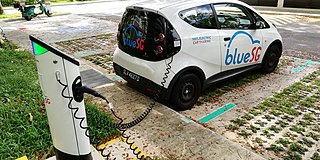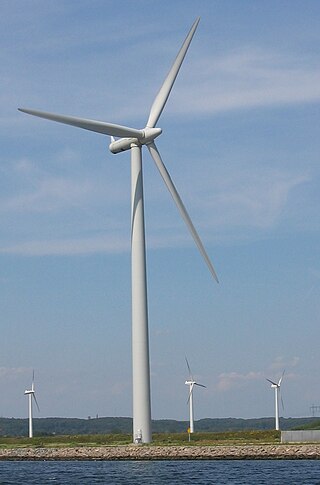Related Research Articles

The European Investment Bank (EIB) is the European Union's investment bank and is owned by the 27 member states. It is the largest multilateral financial institution in the world. The EIB finances and invests both through equity and debt solutions companies and projects that achieve the policy aims of the European Union through loans, equity and guarantees.
A green economy is an economy that aims at reducing environmental risks and ecological scarcities, and that aims for sustainable development without degrading the environment. It is closely related with ecological economics, but has a more politically applied focus. The 2011 UNEP Green Economy Report argues "that to be green, an economy must not only be efficient, but also fair. Fairness implies recognizing global and country level equity dimensions, particularly in assuring a Just Transition to an economy that is low-carbon, resource efficient, and socially inclusive."

China Development Bank (CDB) is a policy bank of China under the State Council. Established in 1994, it has been described as the engine that powers the national government's economic development policies. It has raised funds for numerous large-scale infrastructure projects, including the Three Gorges Dam and the Shanghai Pudong International Airport.

Clean technology, also called cleantech or climatetech, is any process, product, or service that reduces negative environmental impacts through significant energy efficiency improvements, the sustainable use of resources, or environmental protection activities. Clean technology includes a broad range of technology related to recycling, renewable energy, information technology, green transportation, electric motors, green chemistry, lighting, grey water, and more. Environmental finance is a method by which new clean technology projects can obtain financing through the generation of carbon credits. A project that is developed with concern for climate change mitigation is also known as a carbon project.

The Alliance to Save Energy is a bipartisan, nonprofit coalition of business, government, environmental, and consumer groups based in Washington, D.C. The Alliance states that it advocates for "energy-efficiency policies that minimize costs to society and individual consumers, and that lessen greenhouse gas emissions and their impact on the global climate." The Alliance's chief activities include public relations, research, and lobbying to change U.S. energy policy.

The Development Bank of Southern Africa (DBSA) is a development finance institution wholly owned by the Government of South Africa. The bank intends to "accelerate sustainable socio-economic development in the Southern African Development Community (SADC) by driving financial and non-financial investments in the social and economic infrastructure sectors".

Socially responsible investing (SRI) is any investment strategy which seeks to consider financial return alongside ethical, social or environmental goals. The areas of concern recognized by SRI practitioners are often linked to environmental, social and governance (ESG) topics. Impact investing can be considered a subset of SRI that is generally more proactive and focused on the conscious creation of social or environmental impact through investment. Eco-investing is SRI with a focus on environmentalism.
The Climate Investment Funds (CIF) was established in 2008 as a multilateral climate fund in order to finance pilot projects in developing countries at the request of the G8 and G20. The CIF administers a collection of programs with a view of helping nations fight the impacts of climate change and accelerate their shift to a low-carbon economy. Through contributions from 14 donor countries, CIF supports more than 350 projects in 72 low and middle-income countries on the frontlines of the climate crisis.
Conservation finance is the practice of raising and managing capital to support land, water, and resource conservation. Conservation financing options vary by source from public, private, and nonprofit funders; by type from loans, to grants, to tax incentives, to market mechanisms; and by scale ranging from federal to state, national to local.

The Eurasian Development Bank (EDB) is an international development finance institution investing in the development of the economies, trade and other economic ties, and integration in Eurasian countries. The EDB was founded in 2006 and is headquartered in Almaty, Kazakhstan. The Bank has a branch in St. Petersburg and representative offices in Astana, Bishkek, Dushanbe, Yerevan, Minsk, and Moscow.
Environmental, social, and governance (ESG), is a set of aspects, including environmental issues, social issues and corporate governance that can be considered in investing. Investing with ESG considerations is sometimes referred to as responsible investing or, in more proactive cases, impact investing.
Eco-investing or green investing is a form of socially responsible investing where investments are made in companies that support or provide environmentally friendly products and practices. These companies encourage new technologies that support the transition from carbon dependence to more sustainable alternatives. Green finance is "any structured financial activity that has been created to ensure a better environmental outcome."

Climate finance is an umbrella term for loans, investments, and other forms of financial capital allocation in the area of climate change mitigation, adaptation and/or resiliency.
Blended finance is defined as "the strategic use of development finance and philanthropic funds to mobilize private capital flows to emerging and frontier markets", resulting in positive results for both investors and communities. Blended finance offers the possibility to scale up commercial financing for developing countries and to channel such financing toward investments with development impact. As such, blended finance is designed to support progress towards the Sustainable Development Goals (SDGs) set forth by the United Nations. Meeting the SDGs will require an additional $2.5 trillion in private and public financing per year as of 2017 estimates, and an additional $13.5 trillion to implement the COP21 Paris climate accord. The concept of blended finance can contribute to raising the private financing needed. It was first recognized as a solution to the funding gap in the outcome document of the Third International Conference on Financing for Development in July 2015.
There is enormous potential for renewable energy in Kazakhstan, particularly from wind and small hydropower plants. The Republic of Kazakhstan has the potential to generate 10 times as much power as it currently needs from wind energy alone. But renewable energy accounts for just 0.6 percent of all power installations. Of that, 95 percent comes from small hydropower projects. The main barriers to investment in renewable energy are relatively high financing costs and an absence of uniform feed-in tariffs for electricity from renewable sources. The amount and duration of renewable energy feed-in tariffs are separately evaluated for each project, based on feasibility studies and project-specific generation costs. Power from wind, solar, biomass and water up to 35 MW, plus geothermal sources, are eligible for the tariff and transmission companies are required to purchase the energy of renewable energy producers. An amendment that introduces and clarifies technology-specific tariffs is now being prepared. It is expected to be adopted by Parliament by the end of 2014. In addition, the World Bank's Ease of Doing Business indicator shows the country to be relatively investor-friendly, ranking it in 10th position for investor protection.

A green bank is a financial institution, typically public or quasi-public, that employs innovative financing techniques and market development tools in collaboration with the private sector to expedite the deployment of clean energy technologies. Green banks use public funds to leverage private investment in clean energy technologies that, despite their commercial viability, have struggled to establish a widespread presence in consumer markets. Green banks aim to reduce energy costs for ratepayers, stimulate private sector investment and economic activity, and expedite the transition to a low-carbon economy.
Green finance is officially promoted as an important feature of the Belt and Road Initiative, China's signature global economic development initiative. The official vision for the BRI calls for an environmentally friendly "Green Belt and Road".
Sustainable finance is the set of practices, standards, norms, regulations and products that pursue financial returns alongside environmental and/or social objectives. It is sometimes used interchangeably with Environmental, Social & Governance (ESG) investing. However, many distinguish between ESG integration for better risk-adjusted returns and a broader field of sustainable finance that also includes impact investing, social finance and ethical investing.
Sustainability Bonds are fixed-income financial instruments (bonds) where the proceeds will be exclusively used to finance or re-finance a combination of Green and Social Projects and which are aligned with the four core components of the International Capital Market Association (ICMA) Green Bonds Principles and Social Bonds principles.
A Sustainability-linked bond (SLB) is a fixed income instrument (Bond) where its financial and/or structural characteristics are tied to predefined Sustainability/ESG objectives. The objectives are measured through predefined Key Performance Indicators (KPIs) and evaluated against predefined Sustainability Performance Targets (SPTs).
References
- ↑ "Explaining green bonds". 10 December 2014. Archived from the original on 2020-04-24. Retrieved 2020-04-14.
- ↑ "Climate bonds Standard v2" (PDF). Archived (PDF) from the original on 2019-11-25. Retrieved 2020-04-14.
- ↑ "Green Bond Principles". www.icmagroup.org. Archived from the original on 2020-05-30. Retrieved 2020-05-22.
- ↑ "Green, Social and Sustainability Bonds". Archived from the original on 2020-04-21. Retrieved 2020-04-14.
- 1 2 Yves Hulmann, "2016, l'année de l'essor des obligations vertes" Archived 2016-12-21 at the Wayback Machine , Le temps , 20 December 2016 (page visited on 20 December 2016).
- ↑ "Record 2019 GB Issuance $255bn! EU largest market: US, China, France lead Top 20 national rankings: Sovereign GBs & Certified Bonds gain momentum". Climate Bonds Initiative. 2020-01-16. Archived from the original on 2020-07-28. Retrieved 2020-05-22.
- ↑ "San Francisco Envisions a Solar City". Los Angeles Times. Archived from the original on 2015-12-08. Retrieved 2001-05-17.
- ↑ "San Francisco Proposition H Flyer referencing Global Warming". local.org. Archived from the original on 2003-08-28. Retrieved 2001-06-13.
- ↑ "San Francisco Board of Supervisors ordinance authorizing issuance of revenue bonds under the solar bond authority, charter section 9.107.8" (PDF). sfbos.org. Archived (PDF) from the original on 2019-07-01. Retrieved 2012-06-18.
- ↑ "European Commission – EIB launches largest EUR Climate Awareness Bond (CAB) ever". europa.eu. Archived from the original on 2018-01-04. Retrieved 2018-01-03.
- ↑ "Green Bonds Access Investor Capital to Fight Climate Change". World Bank. Archived from the original on 2017-06-24. Retrieved 2018-01-03.
- ↑ Climate Bonds Initiative (2017). https://www.climatebonds.net/files/files/2016%20GB%20Market%20Roundup.pdf Archived 2017-04-29 at the Wayback Machine
- ↑ "Poland becomes first sovereign state to issue a green bond". businessgreen.com. Archived from the original on 2018-01-04. Retrieved 2018-01-03.
- ↑ EIB Group Sustainability Report 2021. European Investment Bank. 2022-07-06. ISBN 978-92-861-5237-5.
- ↑ "Reports". Climate Bonds Initiative. Retrieved 2022-08-08.
- ↑ Curtis, Simon; Klaus, Ian (2024). The Belt and Road City: Geopolitics, Urbanization, and China's Search for a New International Order. New Haven and London: Yale University Press. doi:10.2307/jj.11589102. ISBN 9780300266900. JSTOR jj.11589102.
- ↑ Fieldhouse, Stuart (2020-10-15). "UK's first local government green bond issue closes five days early". The Armchair Trader. Archived from the original on 2020-10-17. Retrieved 2020-10-16.
- ↑ Stubbington, Tommy (21 September 2021). "UK's debut 'green gilt' sale draws blockbuster demand". Financial Times. Archived from the original on 21 September 2021. Retrieved 21 September 2021.
- ↑ Blackwell, Richard (14 September 2014). "SolarShare grows as 'green bonds' heat up". The Globe and Mail. Archived from the original on 29 October 2021. Retrieved 14 October 2021.
- ↑ "Community Bonds that turned Waste into Power". 8 July 2021. Archived from the original on 27 October 2021. Retrieved 14 October 2021.
- ↑ "The Community Bond finds new relevance as a Green Bond". 14 October 2021. Archived from the original on 26 October 2021. Retrieved 14 October 2021.
- ↑ Financial Report 2022. European Investment Bank. 2023-05-08. ISBN 978-92-861-5507-9.
- ↑ Pellicani, Nicholas P. (20 February 2024). "EU Green Bonds Regulation". Debevoise & Plimpton. Retrieved 23 May 2024.
- ↑ Environmental Theme Bonds: a major new Asset Class brewing, excerpt from Sustainable Banking – Risk and Opportunity in Financing the Future, edited by Joti Mangat, published by Thomson Reuters 2010
- ↑ Mathews, Kidney, Mallon, Hughes. Mobilizing private finance to drive an energy industrial revolution. Energy Policy Archived 2021-11-22 at the Wayback Machine 38 (2010)
- ↑ Mackenzie, C and Ascui. F. Investor leadership on climate change: an analysis of the investment community's role on climate change, and snapshot of recent investor activity Archived 2012-04-26 at the Wayback Machine . Published by the UNEP Finance Initiative and UNPRI, 2009.
- ↑ Iggo, C. (2011-03-05). "Climate Bonds: a major new asset class brewing". Archived from the original on 2011-03-05.. Published by Axa Investment Managers
- ↑ "Financing for Sustainable Development Report 2021" (PDF). UN.org.
- ↑ "The Sustainable Development Agenda - United Nations Sustainable Development". www.un.org. Retrieved 2022-08-08.
- ↑ "Transforming our world: the 2030 Agenda for Sustainable Development | Department of Economic and Social Affairs". sdgs.un.org. Retrieved 2022-08-08.
- 1 2 3 Guide: New markets for green bonds Archived 2019-02-24 at the Wayback Machine , the Climate and Development Knowledge Network, access-date 25 July 2017
- ↑ Global green bond issuance could rise to USD206B in 2017 after record in 2016 Archived 2017-08-06 at the Wayback Machine , New York, NY: Moody's Investors Service, Inc. access-date 25 July 2017
- ↑ Better business, better world: The report of the Business & Sustainable Development Commission Archived 2017-08-06 at the Wayback Machine , access-date 25 July 2017
- ↑ Sustainable development bonds Archived 2017-02-23 at the Wayback Machine EIIL, 2016
- ↑ Finance gap: the adaptation report Archived 2017-05-10 at the Wayback Machine , United Nations Environment Programme (UNEP), access-date 25 July 2017
- ↑ The role of the Green Climate Fund in providing the missing "clean trillion" Archived 2017-08-06 at the Wayback Machine , COP Blog, Environmental Finance, access-date 25 July 2017
- ↑ "AIFC documents on green finance". AIFC Green Finance Center. Archived from the original on 2020-07-28. Retrieved 2020-05-24.
- ↑ Doran, M. (2019). "Critical challenges facing the green bond market" (PDF).
- ↑ "Green Bond Principles and the EU framework for green finance". www.ibanet.org. Retrieved 2023-11-03.
- ↑ Tuhkanen, Heidi; Vulturius, Gregor (2022-10-02). "Are green bonds funding the transition? Investigating the link between companies' climate targets and green debt financing". Journal of Sustainable Finance & Investment. 12 (4): 1194–1216. doi: 10.1080/20430795.2020.1857634 . ISSN 2043-0795.
- ↑ Matsuzaki, Yusuke. "Environmental bonds stained by 'green washing'". Nikkei Asian Review. Archived from the original on 3 October 2018. Retrieved 4 October 2018.
- 1 2 Whiley, Andrew (23 May 2017). "An oil & gas bond we knew would come eventually: Repsol: Good on GBPs, not so sure on green credentials". Climate Bonds Initiative. Archived from the original on 4 October 2018. Retrieved 4 October 2018.
- ↑ "The Vigeo Eiris shock: from ethics to occupation". Western Sahara Resource Watch. Archived from the original on 4 October 2018. Retrieved 4 October 2018.
- ↑ Henide, Karim (2021-12-22). "Green lemons: overcoming adverse selection in the green bond market". Transnational Corporations. 28 (3): 35–63. doi:10.18356/2076099x-28-3-2. S2CID 245453922.
- ↑ MacAskill, S.; Roca, E.; Liu, B.; Stewart, R.A.; Sahin, O. (January 2021). "Is there a green premium in the green bond market? Systematic literature review revealing premium determinants". Journal of Cleaner Production. 280: 124491. doi:10.1016/j.jclepro.2020.124491. hdl: 10072/400331 .